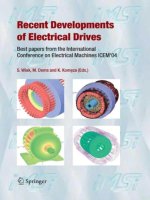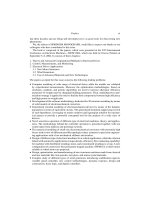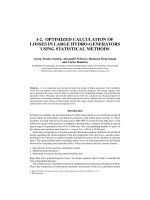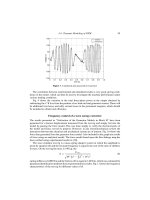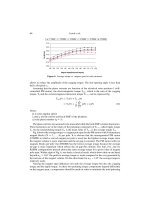Recent Developments of Electrical Drives - Part 8 pdf
Bạn đang xem bản rút gọn của tài liệu. Xem và tải ngay bản đầy đủ của tài liệu tại đây (371.41 KB, 10 trang )
56 Kolehmainen
Table 2. Comparison of nominal load results
Measured Calculated Calculated Calculated
V-shape V-shape U-shapeA U-shapeB
T
n
[Nm] 875 875 875 875
I
n
[A] 46.5 45.5 45.8 45.4
Cos
ω
0.993 0.997 0.997 1.000
η
0.929 0.946 0.939 0.938
Angle 32.6 29.7 25.4
T
k
[Nm] 1,688 1,557 1,418
I
k
[A] 122.5 113.8 98.5
Cos
ω
0.856 0.841 0.804
Angle 114.1 111.5 99.2
Magnets thickness 7.3 7.3 5.15
Magnets width 52 52 72.2
Magnets area 379.6 379.6 371.83
current. Only copper losses in stator winding are taken account in efficiency η calculations.
Other losses are relatively small.
In the table first calculated U-shapeA results are calculated with the design with same
total magnet length and thickness per pole than with V-shape design. The second calculated
results U-shapeB are calculated with design with longer and thinner magnets per pole.
Magnets thickness, width, and area are also shown in the table with unit of mm. Dimensions
of V-shape design are real dimensions of one magnet and for U-shape designs dimension
are values which corresponds values of V-shape design.
The maximum output torque with the first U-shapeA design is smaller than with the V-
shape design and it has also smaller load angle difference. This is due to smaller reluctance
torque and effect of iron bridges between the magnets. Torque and reluctance torque curves
are shown in Fig. 10.
Figure 10. Torque and reluctance torque of motors with V- and U-shape designs as a function of load
angle.
I-5. Finite Element Analysis of PMSM with Buried Magnets 57
Figure 11. Power factor as a function of torque.
Reluctance torque is larger with V-shape than with U-shapeA design, because the mag-
netic structure of rotor. By comparing torques of U-shapeA and U-shapeB designs can also
see the effect of decreasing of magnet thickness.Reluctanceand maximum torque is smaller
with thicker magnets.
Power factors of V-shape and U-shape designs are shown as a function of torque in
Fig. 11. Power factor of the motor with the U-shapeA design is larger up to the nominal
point and with the higher torque it is smaller. Nominal torque of the motors is 875 Nm
and usually the motors are used with partial loads with different speeds. Hence, the motor
with the U-shape magnets is usually in the torque range with better power factor. Also the
maximum torque decreases because of the smaller reluctance. With the longer and thinner
magnets in the V-shapeB design there is smaller maximum torque and higher power factor
with nominal load as can be expected.
ThereissignificantdifferenceoftorquesbetweenV-and U-shapeAdesigns. Thisis shown
in the Fig. 12. With the U-shapeA design, the oscillation of torque is with the frequency of
magnets going over stator phase. With the V-shape design oscillation frequency is two times
of frequency with U-shapes, because two magnets go over one stator phase with V-shape
Figure 12. Torque oscillations of V-shape and U-shapeA designs.
58 Kolehmainen
design while one magnet going over one stator phase with U-shapeA design. In addition
the amplitude is smaller with V-shapes.
Conclusion
It is shown that the PM motor with the U-shape magnets in every second pole works as
well as the conventional PM motor with the V-shape magnets in every pole. Asymmetrical
structure of pole pairs in this design cause no asymmetry to the magnetic field of air gap.
This design gives a possibility to get higher flux densities with the sameamount of magnets.
The number of magnet pieces is also reduced.
Torque oscillation with U-shapeA design is too high compared to V-shape design. This
could be avoided with using different stator slots or iron structure near the magnets and air
gap.
In conclusion, this new solution gives more possibilities to produce buried permanent
motors with better power factor and efficiency.
References
[1] J. Salo, T. Heikkil¨a, J. Pyrh¨onen, T. Haring, “New Low-Speed High-Torque Permanent Magnet
Synchronous Machine With Buried Magnets”, International Conference Electrical Machines
(ICEM 00), Vol. 3/3, Espoo, Finland, August 28–30, 2000, pp. 1246–1250.
[2] F.Libert,J.Soulard, J.Engstr¨om,“Design ofa4-pole LineStartPermanent Magnet Synchronous
Motor”, International Conference Electrical Machines (ICEM 02), Brugge, Belgium, August
25–28, 1998, p. 173.
[3] Flux2D Software, www.cedrat.com.
I-6. DESIGN TECHNIQUE FOR
REDUCING THE COGGING
TORQUE IN LARGE SURFACE-MOUNTED
MAGNET MOTORS
R. Lateb
1
, N. Takorabet
1
, F. Meibody-Tabar
1
, J. Enon
2
and A. Sarribouette
2
1
INPL–GREEN, 2 avenue de la forˆet de Haye, 54516 Vandoeuvre-l`es-Nancy, France
, ,
2
Converteam, 4 rue de la Rompure, 54250 Champigneulles, France
,
Abstract. An approach based on magnets segmentation is introduced for minimizing the cogging
torque of surface-mounted permanent magnet motors. The authors show that the magnet segmen-
tation has also an effect on the ripple torque especially on its high order harmonics. However, this
technique has a small effect on the main performancesof the motor such as the average torque. So, the
segmentation number is chosen according to the choice of the magnet span and the stator winding. An
approach based on Fourier analysis is used to justify the numerical results obtained by finite elements
method.
Introduction
The use of high power surface-mounted permanent magnet (PM) motors in different in-
dustrial applications (windmill generator, marine propulsion, traction ) is very attractive
thanks to their high torque density [1]. The design of PM motors must take into account the
requirements of such applications. One of the most important constraints is the mechanical
shaft vibrations, especially at low speeds, that can be avoided by reducing the amplitude of
torqueharmonics.Thiscanbe achievedbyusing awiderange oftechniquesproposedbysev-
eral authors [2]. Some of these techniques are based on modifying the current waveformsto
canceltorquepulsationsforanyPM motorwithknownelectromotiveforce(EMF)waveform
[3]. If the EMF is not sinusoidal, high dynamic current waveform is required which is diffi-
cult to apply by high power inverters. The othertechniques are based on structural solutions.
The first structural solution consists in an adapted choice of the stator winding for a
given number of stator slots [4]. Even if this solution allows to minimize the ripple torque
rate due the interaction between stator currents and rotor magnets, it has no effect on
the cogging torque since the stator slots design is chosen. As well known in PM motors,
S. Wiak, M. Dems, K. Kom
˛
eza (eds.), Recent Developments of Electrical Drives, 59–72.
C
2006 Springer.
60 Lateb et al.
cogging torque arises from the interaction between magnets and slotted iron stator. Another
solution consists to optimize the magnets pole angular width (span). Even if this geometrical
parameter allows to reduce the cogging torque, it is often used to maximize the average
torque and to minimize the ripple torque rate for an imposed current waveform. It has
shown that a classical requirement to eliminate the cogging torque first harmonic is to
choice a magnet pole span almost a multiple of slot pitch [5–7]. It’s obvious that motors
with closed slots or slotless stator have no cogging torque. These solutions, which lead to
mechanical difficulties, can be approached by introducing magnetic wedges in slots that
reduces significantly the cogging torque. It has been shown that choosing equal tooth and
slot width may diminish the fundamental component of the cogging torque [5]. In fact, for
a given slot pitch, there is several values of tooth width which minimize the cogging torque.
A teeth-pairing design with different tooth widths as well as the teeth notching design
is other techniques that allow to reduce the cogging torque [8]. One of the most popular
techniques to reduce cogging torque is to skew the stator lamination stack or rotor magnets
[9]. Ideally, the cogging torque is vanished with a skewing angle of integer multiple of
the cogging torque period. Stator skewing is less interesting because of a more complex
construction. To make easier the rotor manufacturing, the rotor skewing may be done by
placing the PM axially skewed by several discrete steps [9]. All the techniques cannot be
related in this paper but one can find a large bibliography in [2].
In high power PM motors, the magnet pole span is too large for being realized in only
one block. For technical and cost considerations, each rotor pole is often realized with
several elementary magnet blocks with the same polarity (magnet segmentation). In this
paper, the authors present the effect of the magnets segmentation on the machine perfor-
mances. One can expect that the segmentation of the magnets does not modify signifi-
cantly the main performances since the magnet span conserves the same value. However,
the magnets segmentation modifies locally the air-gap magnetic field distribution which
leads not only to a significant modification of the cogging torque but also the back EMF
harmonics.
In the second section, using analytical approaches, we present different techniques re-
ducing the cogging torque. For the sake of the analyze of the cogging torque minimization,
the analytical method is useful but not enough precise to evaluate its exact shape and its
amplitude. In the third section we present the used numerical finite elements method. In
the last part of this paper, for different values of the magnet span, we analyze the influence
of magnets segmentation on the performances (Average torque, Harmonics of back EMF,
cogging torque, Pulsating torque) of a surface-mounted PM motor.
The obtained results and the carried out analysis highlight that for a given value
of a magnet pole span, it exists an optimal number of magnet blocks per pole for
which the best compromise between average torque and pulsating torque rate may be
achieved.
Used techniques for cogging torque minimization
The cogging torque being caused by the interaction between the rotor magnets and the
stator teeth. The main parameters which affect significantly its shape and amplitude are: the
I-6. Design Technique for Reducing the Cogging Torque 61
(a)
(b)
stator
rotor
N
S
τ
s
τ
p
=6τ
s
stator
rotor
N
S
τ
s
=6.5τ
s
Figure 1. Two cases of symmetric distribution: (a) two poles, 12 slots; (b) two poles, 13 slots.
number of stator teeth, the magnet pole span,and the magnet segmentation. In the following
we detail how to choose these parameters to minimize the cogging torque.
Number of slot
In a PM motor with N
sp
stator slots per pole pair, the contribution T
cm
of one magnet to the
cogging torque is of the form:
T
cm
(θ) =
∞
h=1
T
h
sin(hN
sp
θ) (1)
Where T
h
, is the Fourier coefficient of the hth harmonic. θ is the electrical angular position.
To illustrate the interest of an odd number of stator slots per pole pair, we consider a pole
pair of a PM motor as shown in Fig. 1. The cases of N
sp
= 12 (Fig. 1a) and N
sp
= 13 (Fig.
1b) are considered.
In Fig. 1(a), we can observe that each magnet has the same relative position with re-
spect to the stator teeth. The cogging torque per pole pair is twice the contribution of one
magnet.
T
cp
(θ) = 2
∞
h=1
T
h
sin(hN
sp
θ) (2)
In the second case, the magnets have not the same relative position with respect to the
stator teeth. Since one magnet has a half slot pitch electrical shift angle θ
0
=
π
N
sp
, the
62 Lateb et al.
cogging torque per pole pair becomes:
T
cp
(θ) =
∞
h=1
T
h
sin(hN
sp
θ) +sin(hN
sp
(θ −θ
0
))
(3)
Hence:
T
cp
(θ) =
∞
h=1
T
h
sin(hN
sp
θ)(1 +cos(hN
sp
θ
0
)
−cos(hN
sp
θ)sin(hN
sp
θ
0
)
(4)
By replacing the expressionofθ
0
in (4), one can show that thefundamentalofthecogging
torque (h = 1) is eliminated as well as all odd harmonics. Indeed, in this case only the even
harmonics (2 × N
sp
) of the Fourier decomposition subsist.
In the general case, one can demonstrate that for a symmetric distribution of N
p
magnets
and N
s
slots in the motor, the fundamental frequency of the cogging torque is the least
common multiple (LCM) of N
p
and N
s
.
N
L
= LCM(N
p
, N
s
) (5)
High power low speed PM motors offer the possibility to use a large number of slots per
pole that allows to increase the frequency of the cogging torque first harmonic. Moreover,
as illustrated above, using an odd number of slots per pole pair doubles the frequency of
the cogging torque.
Trailing edge
magnet
Produced torque at the trailing
edge with the tooth 1.
1234
34
34
12
12
Leading edge
magnet
magnet
Figure 2. Simple model of cogging torque mechanism.
I-6. Design Technique for Reducing the Cogging Torque 63
Magnet span
The motor cogging torque is mainly caused by the interactions of magnets edges (trailing
and leading edges) and stator teeth. Thus, the study of the cogging torque can be reduced
to the analysis of these interactions.
By ignoring the effect of rotor curvature, magnet leakage flux, and fringing flux and by
bringing back to a rectangular field problem, one can represent the mechanism of cogging
torque production by the simple model illustrated in Fig. 2, where the dashed lines represent
the area in which the main part of magnetic energy is stored.
For the three magnet positions shown in Fig. 2, the variation of the magnetic energy
under the tooth 1 during the passage of the trailing edge is illustrated, while the energy
under the other teeth (2, 3, 4) doesn’t vary. The produced torque due to the passage of the
trailing edge is proportional to this energy variation. It is a periodic function that can be
expressed as:
T
trailing
(θ) = T
0
+
∞
h=1
T
h
cos(hN
sp
θ) (6)
Let’s define α
m
as the electrical shift angle between the leading and trailing edges. The
torque produced by the leading edge is the opposite of the one produced by the trailing edge
shifted by α
m
.
T
leading
(θ) =−T
0
−
∞
h=1
T
h
cos(hN
sp
(θ −α
m
)) (7)
Then the expression of the cogging torque, produced by this magnet, becomes:
T
cm
(θ) =
∞
h=1
T
h
cos(hN
sp
θ) −cos(hN
sp
(θ −α
m
))
(8)
Under the assumptions mentioned above, from (8) it can be easily shown that the cogging
torque can be eliminated by choosing:
α
m
=
2πk
N
sp
= τ
s
k (9)
with k an integer and τ
s
the electrical slot pitch angle.
This condition, indicating that the angle α
m
must be a multiple of a slot pitch, is obtained
underthementioned assumptions,which don’ttake intoaccountthe effectof rotorcurvature,
magnet leakage flux and fringing flux. Considering thesephenomena, a zero cogging torque
cannot be achieved. However, according to different authors, using finite element analysis,
the cogging torque may be minimized for a magnet span of α
m
= (n +0.14)τ
s
by ignoring
the effect of rotor curvature [5] or (n +0.17)τ
s
by considering the effect of rotor curvature
[6] or (n + 0.25)τ
s
for linear motors [7].
Magnets segmentation
As previously said, for manufacturing and cost reasons, in large permanent magnet motor
each rotor pole is often realized with several elementary magnet blocks with the same
polarity (magnets segmentation). In the following, a cur ved shape magnet is used for each
64 Lateb et al.
magnet
α
s
air-gap
stator
β
γ
rotor
Figure 3. Representation of an elementary RSMM.
nonsegmented rotor pole and rectangular cross-section magnet blocks are used for realizing
each pole of a segmented permanent magnet machine. For the sake of simplicity, we will
use the next abbreviations:
r
RSMM: Rectangular Surface-Mounted Magnets with parallel magnetization.
r
CSMM: Curved Surface-Mounted Magnet per pole.
For a CSMM motor, the mechanical air-gap is constant (CSMM is delimited by the red
dashed lines in Fig. 3), while in the RSMM motor the air-gap varies.
Fig. 3 shows the geometrical representation of an elementary RSMM. The relation
between the whole magnet pole span α
m
and the elementary block magnets span γ is:
α
m
= Nγ
γ = α
s
+ 2β
(10)
where N is the number of elementary magnet blocks forming each pole, α
s
the opening
angle of the elementary magnet facing the air-gap, and β half of the opening angle of the
slit between two elementary magnet blocks. The span of each elementary magnet block is
expressed in term of the slot pitch in the same way adopted above:
γ = (n ± ε)τ
s
0 ≤ ε<1
(11)
where n is an integer.
Usingtheresultsgivenin [6],the optimalspanofeachelementarymagnetblockshouldbe
such as ε ≈ 0.17. However this result has been obtained for CSMM motor. For rectangular
magnets (RSMM) motors the optimum value of ε will be probably modified.
Numerical analysis
Finite elements method is used for the computation of the machine characteristics. In order
to increase the precision of the results and especially the computation of the cogging torque,
a finer mesh is applied all around the air-gap [10], at each rotor position the meshing is
renewed.Thanks to geometrical andelectricalsymmetries,onlyonepolepair of the machine
is considered, it allows a minimum time consuming. In addition, for each design we made
the calculations for 60 different rotor positions over a slot pitch. The number of nodes is
more than 40,000 nodes. The computations take into account the saturation of iron core.
I-6. Design Technique for Reducing the Cogging Torque 65
Figure 4. PM motor with six rectangular magnet blocks.
The cogging torque is computed through the Maxwell weighted stress tensor method [11]
and the used software for the computation is FEMM [12].
Fig. 5 shows a cross-section view of a PM motor in three configurations where each
magnet pole is divided in two, three, or four blocks. In the following, the performances
of the segmented PM motor having N elementary magnet blocks (N = 1, ,6) per pole
are computed (Fig. 6). These performances will be presented vs. the total magnet span
α
m
= Nγ.
Results
Thecomputationsare performed fora6 MW, 16-poles,170rpm,surface-mounted PMmotor
supplied by sinusoidal waveform currents. An adapted stator winding with a fractional slot
number per pole and per phase (15 slots per pole pair) allows to reduce considerably the
space harmonics of stator magnetomotive force (MMF), especially the fifth one which is
totally cancelled. Another advantage of using an odd slot number over a pole pair is to
increase the pulsation of the cogging torque. So, for the studied topology the cogging torque
period is 2π/30 electrical degrees. Magnetic wedges used in the slot openings (isthmus),
(a) (b) (c)
Figure 5. Cross-section view of one pair pole of the PM motors with: (a) two magnet blocks per pole;
(b) three magnet blocks per pole; (c) four magnet blocks per pole.

